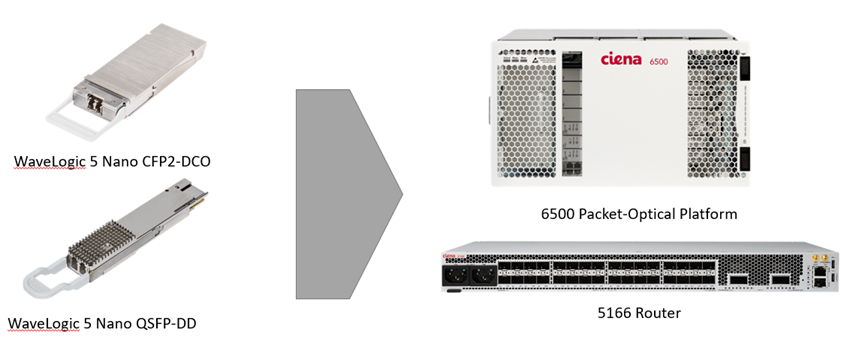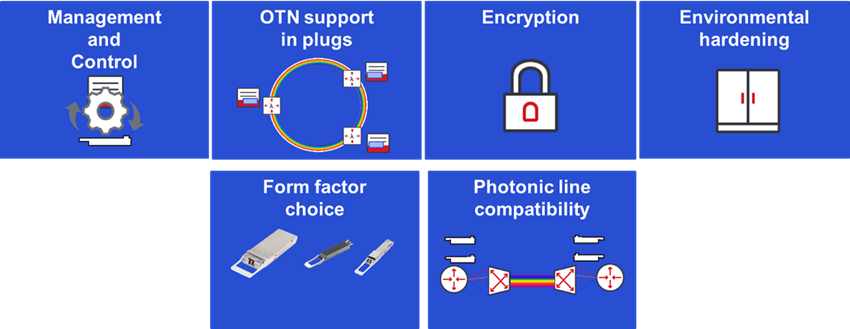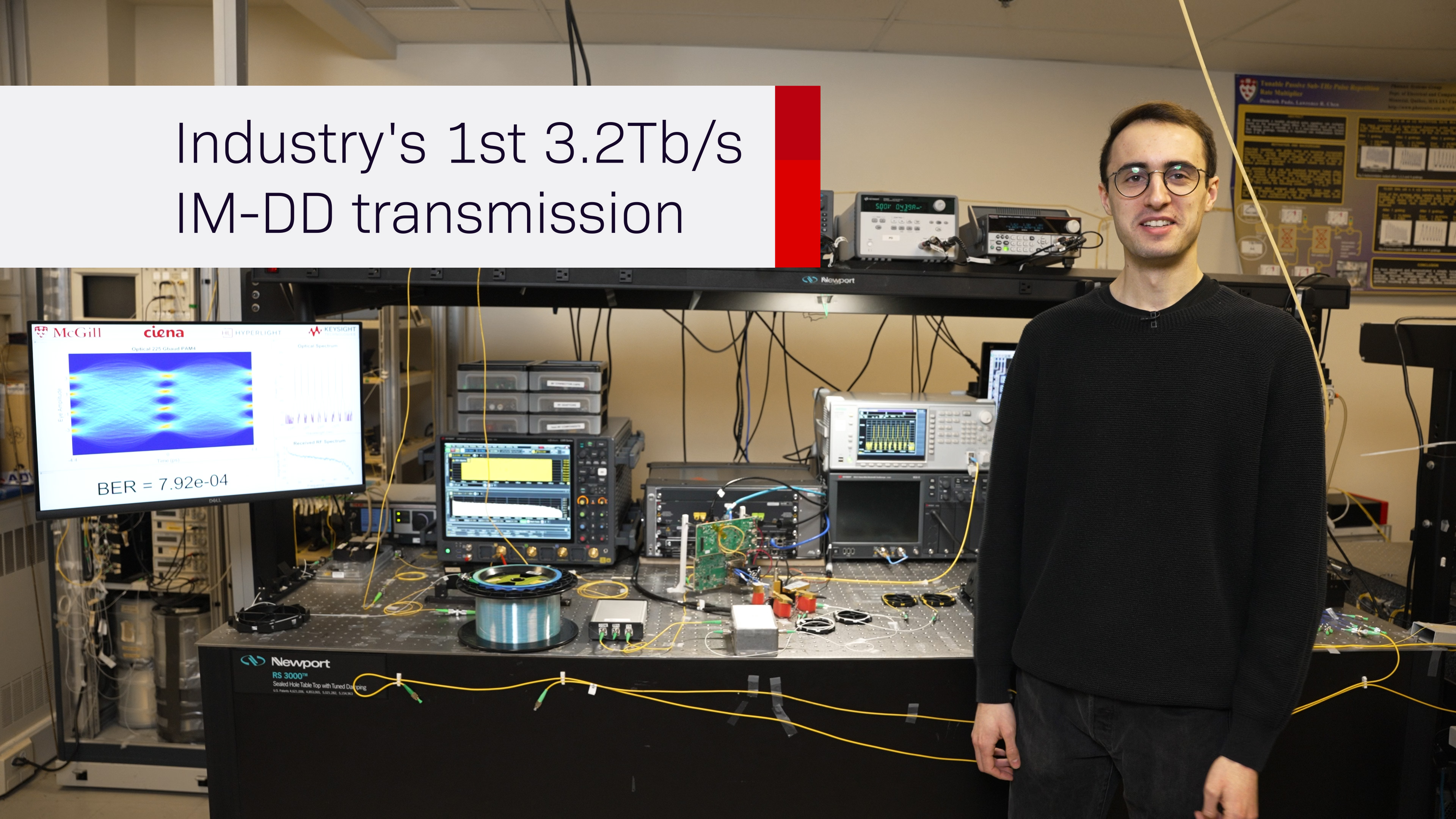Preparing coherent pluggables for prime time: practical deployment considerations
Network evolution – why coherent plugs?
 Coherent optics are used in a full range of network transport applications from short-80km-reach single-span DCI through to thousands of kilometers of subsea cable links. A mix of both performance-optimized and footprint-optimized coherent optics are used, the former where reach and spectral efficiency are key requirements and the latter where minimizing power and area are critical. Footprint-optimization is the domain of coherent pluggables where the design parameters of coherent optical technology have been adapted to conform to smaller packages with lower power. The combined shrink in power and area pave the way for the modularity and density that pluggable sockets offer on router and transport platforms.
Coherent optics are used in a full range of network transport applications from short-80km-reach single-span DCI through to thousands of kilometers of subsea cable links. A mix of both performance-optimized and footprint-optimized coherent optics are used, the former where reach and spectral efficiency are key requirements and the latter where minimizing power and area are critical. Footprint-optimization is the domain of coherent pluggables where the design parameters of coherent optical technology have been adapted to conform to smaller packages with lower power. The combined shrink in power and area pave the way for the modularity and density that pluggable sockets offer on router and transport platforms.

Figure 1: Coherent pluggable applications
Footprint-optimized design challenges
The use of semiconductor technology is a fundamental pillar of coherent optical technology and one of the key innovation paths through multiple generations of coherent optical Digital Signal Process (DSP) chips. Shrinking electrical design functionality at the component level is not exclusive to optical communications systems. But what differentiates optical systems design, and adds to the challenge for footprint-optimization, is the need to shrink the optics in-parallel with the electronics. To realize coherent optical technology in small form factor, pluggable packages for the new short-reach applications discussed above requires a confluence of key engineering skills, intensive investment, technology ownership and deep understanding of all aspects of networking requirements.
Leveraging vertical integration, designing coherent pluggables from the ground up requires the latest semiconductor process technology for greatest functionality and lowest power in the coherent DSP chip. For the optics, silicon photonics is a critical foundational technology, offering the ability to integrate optical functions in a manner analogous to the integrated circuit in electronics. Silicon photonics offers the performance, power and volume manufacturability that meets the design requirements for coherent pluggables. The ability not just to design the individual semiconductor and silicon photonics components but to take advantage of advanced packaging techniques to bring all the elements together, along with direct fiber attach, achieves the footprint-optimization goal. Alongside co-optimized design of the multiple component elements, an understanding of network-level performance and functional requirements paves the way for coherent pluggables that meet real-world deployment needs.

Figure 2: Important design elements for 100G – 400G pluggables
Real-world coherent pluggable deployment
To enable coherent pluggable deployments, the challenges are multi-fold. Foundational technology ownership and design, technology and manufacturability elements are required to ensure the right features and performance in the core components. Once those challenges are met, other considerations come into play to ensure that the resulting packaged pluggable module is compatible both with the system platform socket and the specific requirements for a given target application.
A key element for successful integration and deployment of coherent pluggables are management interfaces, the glue between coherent plug and host platform. The Multi-Source Agreement (MSA) bodies that define form factors exist independently from the MSA organizations and standards bodies that define transmission specifications or coherent technology implementation guides. These specifications are written with certain target pluggable form factors in mind which meet the application requirements. Form factor MSA had existing protocols like the Common Management Interface Specification (CMIS). It was necessary to rework and update this specification to incorporate the additional management functions required to support coherent optical transmission in a plug. This led to a definition for Coherent-CMIS or C-CMIS. This effort was started in the Optical Internetworking Forum (OIF) for 400ZR, leveraging CMIS from the QSFP-DD MSA body. As coherent plugs get more complex and feature-rich, the management interfaces will also have to be adapted again.
Another important element of pluggable deployment is the choice of module form factor and the physical environment for the deployment. Different form factors play a large role in determining what features and performance can be realized. The mechanical and thermal constraints of the pluggable package steer the optimization of coherent pluggable design to optimize for different applications. This optimization effort also helps achieve the key benefits of coherent pluggables: power and cost reduction.

Figure 3: Examples of WaveLogic 5 Nano Coherent Pluggable Offerings
Various networking features and operational requirements also need careful consideration in the design phase for coherent pluggables. Deploying coherent pluggables together with DWDM photonic line systems requires compatibility of the output signal with the channel plan and associated mux/demux and filters. This optimization has a direct impact on the total fiber capacity and reach performance of the coherent pluggable deployment. Planning support for encryption in the context of a coherent pluggable deployment leads to a host of different issues including, but not limited to, authentication and certification. OTN functionality in a coherent plug requires many factors to be dealt with, in particular where connector pin-count limitations of certain form factors can restrict features. Hardening for exterior cabinet deployments must be designed in from the start and this means ensuring internal components are equally robust in operation. Finally, including support for multi-vendor line interoperability, where required, requires attention be paid to both the specifications from the standards body and the form factor MSA.

Figure 4: Networking and operational considerations for coherent plugs
New coherent optical choices
Network transformation is driving new requirements which can be serviced by a range of coherent technology choices. Coherent pluggables expand the benefits of coherent technology to help address these transformations. At the same time, the benefits of lower power and cost offered by pluggables present design challenges requiring key skills and careful co-optimization of components. Close attention to a number of different considerations for networking and operational features pave the way for a new generation of 100G – 400G coherent pluggables supporting a wide array of applications.
Want to learn more? Check out this upcoming Omdia webinar that will review applications for coherent pluggable modules and the design and operational considerations for deployment.






